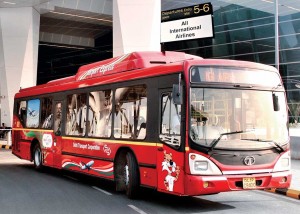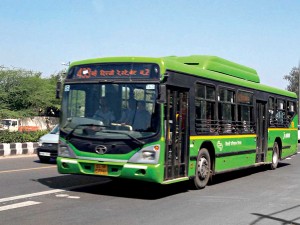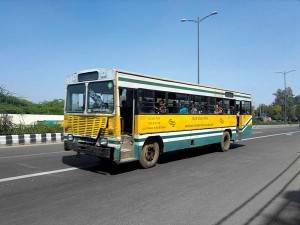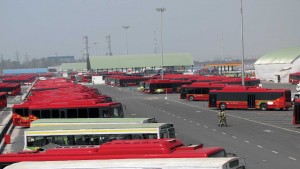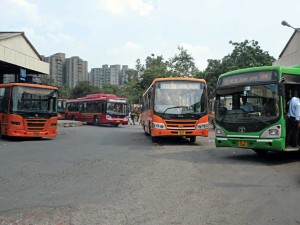The Delhi Transport Corporation operates a modern and dependable bus fleet, which is also the world’s biggest CNG fleet.
Story by: Anirudh Raheja
I am returning home. A red coloured air-conditioned low floor entry bus rolls to a stop in front of me, outside the Indira Gandhi International Airport. Even at 8 am, the temperature is no more than 10 degree Celsius. It is the winter season. Inside the bus, it is warm. A part of the express service, the Delhi Transport Corporation (DTC) operates, the low entry rear-engine Tata Marcopolo bus, moves away with alacrity. I walk over to the ticket issuer, seated like a maharaja with an electronic ticket vending machine. He looks at me without interest, takes the money and hands me the ticket. The journey lasts for an hour and a half as the bus comes to a halt in front of Delhi railway station, past the picturesque Connaught Place, former location of the headquarters of the British Raj built in 1933, and developed as a showpiece of Lutyens’ Delhi with a prominent Central Business District. The low floor height makes it easy for me to alight. The level of occupancy, I remember, was neither too high nor too low. It may perhaps have to do with the fare structure of this particular route. The bus, capable of a refined and comfortable ride, is part of the 4168 buses that DTC runs in the National Capital Region.
Estimated to cater to 1.8 crore people, DTC has been managing world’s biggest Compressed Natural Gas (CNG) powered fleet. Ferrying close to three and a half million passengers daily by operating 4168 buses on 550 routes, DTC, tracing its roots to May 1948 when the Indian Government, under the aegis of the Ministry of Transport took over the local bus services of Delhi, called as the Delhi Transport Service then, and operated by a licensee, the Gwalior and Northern India Transport Company Ltd., has held its own despite competition from modern medias like the Delhi Metro. Constituted under the Road Transport Corporation Act, 1950, and named as the Delhi Transport Corporation under the Road Transport Corporation Act, 1950, DTC, under the Delhi Government continues to be a dependable mode of public transport for the people of Delhi National Capital Region.
Dependable transport
Claiming to transport close to 2.7 million people everyday, Delhi Metro may have succeeded in diverting a good chunk of Delhi’s travelling population away from the overburdened roads of Delhi, it has not managed to take away the task of last mile connectivity that DTC has been doing. Each DTC bus, on an average, travels 210 km per day. According to Dr. R.S. Minhas, DTC spokesperson, the aim is to do a cumulative 10 lakh kms everyday. “Over 90 per cent of this is covered regularly by our fleet, which undertakes 40,000 trips,” he mentions. Over 80 per cent of the DTC buses operate on time. The rest are affected by traffic congestion, and seldom by staff shortage. Supported by Tata Motors and Ashok Leyland, the DTC fleet comprises of front and rear engine buses. There are 1275 rear engine low floor air conditioned buses (painted red), and 2506 low floor non air-conditioned buses (painted bright green). Both bus types comply with the JNNURM scheme. Each low floor bus has a seating capacity of 33. It can accommodate 20 standees. The 387 standard floor buses (yellow coloured) that DTC operates were converted to CNG when the first phase of environmental reforms were rolled out. Most have surpassed DTC’s norm of five-lakh kms and eight years of life. They will soon be phased out according to Dr. Minhas.
Better, greener future
Delhi’s reputation as the most polluted city in the world has ensured that DTC looks at new bus technologies which assure a better and greener future. Expresses Dr. Minhas, “DTC shifted to CNG and followed up with the introduction of low floor rear engine buses.” New, advanced technologies, he adds, are good for public transport as they ensure better sustainability and comfort. If and how the quest for new technologies will help DTC to counter the problem of traffic congestion is the question. For traffic congestion in Delhi can be frustrating. Transport analysts claim that DTC buses, with varying frequency, operate within a range of five to 30 minutes depending upon passenger traffic and route requirement. Traffic congestion adds to their operating time, and the interval between two buses rise. Dr. Minhas is aware of this, and expresses, “It is only when the public will get buses without delay, will they be more willing to shift to public transport.” He claims that one bus can take up to 60 cars off the city roads. He pointing at the odd-even vehicle formula the Delhi Government experimented with twice. It resulted in the travel time of the people of Delhi going down by over 50 per cent according to Dr. Minhas. “The distance covered by DTC buses went up by 98 per cent almost. People were very happy because they were getting buses on time,” he adds.
Subject to extreme weather fluctuations (temperatures can reach 47-50 degree Celsius in summer and close to zero degree Celsius in winter), DTC buses endure a lot of pain. Yet they continue to be a cheaper and comfortable means of travel for many. Operating out of 43 depots, the biggest being the Millennium bus depot on the banks of river Yamuna with a parking space for 800 buses, DTC, in its quest for a greener future, trialed a fully electric bus from BYD recently. Covering 225 kms on a full charge, the battery of the bus takes six hours to be charged fully. “We tested the bus for 16,915 km across different routes (for four months) with heavy and light passenger traffic. We tested the performance of the bus. The operational cost of the bus turned out to be Rs.17.25 per km, almost three-rupees cheaper than that of a CNG bus,” reveals Dr. Minhas. He opines that despite being passenger, driver and environmentally friendly, the initial cost of the bus, which is three times the cost of a conventional bus, is a matter of concern. Surprisingly, the battery does not need replacement for the entire life cycle almost. “At DTC, we are always keen to imbibe the latest technological advancements in bus body designs, engine equipment, technology, systems, etc to be able to provide commuters a comfortable and efficient bus service,” avers Dr. Minhas.
A day in the life of DTC
Transporting 3.5 million commuters everyday, DTC employs 18000 people. The work schedule at DTC stretches over two shifts, and 16 hours. For efficient operation, the equation works such that behind every bus that runs are 7.05 employees. Each bus has 2.65 drivers. Close to 700 DTC buses also double up as school buses. Avers Dr. Minhas, “A DTC bus doubling up as school bus, post student drop off, resumes its public duties from the nearest depot”. He adds, “The peak hour starts at 8 am; DTC buses however start plying from 6 am in the morning.” For efficient operation, up to 11000 buses may be required on any given day. To achieve this goal, the state government sought the services of Delhi Integrated Multi-modal Transit System (DIMTS), a joint venture (JV) established in 2004 between Infrastructure Development Finance Company Ltd (IDFC) and Delhi Government. DIMTS divided Delhi’s 600 bus routes into 17 clusters, and selected private operators through bidding for each cluster. Agreements for seven clusters have been signed. DIMTS is operating 1200 buses according to Dr. Minhas. “Both, DTC and DIMTS, have agreed to follow a joint timetable for consistency in services. Overlapping of two buses on same route is unavoidable due to traffic,” he states.
In an effort to travel to Gurgaon, I wait for a bus at Maharani Bagh. It turns out to be a long wait before the bus arrives. When it does, it is so crowded that getting in is no less than an athletic activity. I somehow manage, and then start hunting for the ticket issuer. Like a maharaja he is seated in some obscure corner. I struggle to get to him; get my pursue out, and hand him the fare charge. I feel like I have won an Olympic gold medal after he hands me the ticket. A chat with commuters reveals that they have to wait for long for the bus to arrive. So, I am not alone. I start thinking if increasing the bus count to 11000 will make a profound difference? Expresses a commuter I speak to, that in a non air-conditioned bus, it can get difficult to breathe during peak hour. Another commuter draws my attention to DTC wanting its commuters to alight from the front. Reaching the front in an overcrowded bus is impossible he reasons. It gets suffocating in winters, he adds. If the views of DTC bus travellers indicate the issues they face, it is easy to understand why preference for cab aggregators like Ola and Uber is rising.
Managing the operations
DTC’s office at Scindia House manages the operation of buses. The operation schedule is sent to respective bus depots. And, the depots take over the bus operation. Driver and conductor matching is done at the depot level. Every depot has a time keeper. His job is to manage bus segregation. His job is also to time the buses coming in and going out of the depot. In each zone, DTC has also placed one regional manager for checking ticket-less travel. “Each manager has four vans which are deployed to check ticket-less travel. This is done not only through regular checks, but also through surprise checks across regions,” explains Dr. Minhas. DTC, with an employee strength of 18000, apart from serving the transportation needs of Delhi, also operates the Delhi to Lahore air-conditioned luxury coaches. These ply thrice a week according to Dr. Minhas. The Pakistan Tourism Development Corporation bus also travels to Delhi thrice a week – on Tuesday, Thursday and Saturday. DTC also operates a bus to Kathmandu, Nepal, regularly.
Minimising breakdowns
A whopping 400 breakdowns (on an average daily) were reported last year. In many cases, the break downs triggered traffic jams. To minimise breakdowns, DTC has put in place a plan. States Dr. Minhas, “Irrespective of the bus route origin and destination, any breakdown of a DTC bus across the city is attended to by a team of mechanics from the nearest depot. This is closely supported by allocation of annual maintenance contracts. “AMC contracts allow us to concentrate on strengthening our services and penalising manufacturers for every breakdown of the bus,” explains Dr. Minhas. Tata Motors and DTC joined hands recently to ensure breakdown free operation of Tata buses in the DTC fleet. Under the initiative, the buses are attended to during their rest period at night. Standard buses are maintained by DTC. A team of 30 people control and keep a bird’s eye view on the maintenance contracts being executed by manufacturers for preventive measures. The team also also keeps tab of the inventory.
Expanding horizons
Despite having the space to park up to 5500 buses, DTC is developing five depots – Seemapuri, Hari Nagar, Wazirabad, Kingsway camp, as pilot projects to double deck park buses using a system developed by PWD. “It will increase the parking capacity of depots by 1.5 times. If it turns out to be successful, we have already earmarked 31 depots out of 43 for double deck parking,” states Dr. Minhas. To support such initiatives, DTC is evaluating ways to increase its earnings. Since 2009, the fare structure has not been revised. Stress therefore is on increasing non traffic revenue through streams like bus ad wrap, depot boundary ad wrap, advertisement LCDs in depots, etc. Not having procured new buses for sometime now, DTC, according to Dr. Minhas, may need to invest in midi-buses considering the rising traffic congestion. “There are many places in Delhi which are always choked because of heavy traffic and where bigger buses take time to transit. Midi-buses at such places can be used, and also at rural areas where passenger travel is less,” he adds. DTC, he reveals, is in the process of procuring low floor buses. Midi-buses may take time.
Going digital
DTC has been technologically upgrading its services with initiatives like electronic ticketing machines and surveillance cameras. Post a few months of testing, the entire DTC fleet will shift to electronic ticketing machines (ETM) for fare collection. Pilot operation is currently on in Rajghat depot and Rohini depot 1 according to Dr. Minhas. Entire fleet conversion should happen by the end of October, he states. This would also help DTC to syndicate with Delhi Metro for fare collection. Delhi Metro card will be usable for fare collection in a DTC bus. “Testing for prepaid fare collection from Delhi Metro cards has brought in good results, and the integrated system will ensure transactions that are segregated in a central clearing house automatically at a certain time slot every day,” states Dr. Minhas. He also points out at CCTVs installed in over 2000 DTC buses on pilot basis. Each bus has three cameras, at front, in the middle and at the rear. These are controlled from the Sarojini Nagar and Rajghat depots. “The control room keeps the footage for one month. Complaint-based footages are kept as records for longer. In the next two years, all DTC buses will be fitted with CCTV cameras. For women security, we have deployed 8000 marshals in uniforms, especially during late night travel,” informs Dr. Minhas. He adds, “There are plans to launch full fledged public information system. We are also gearing up to offer app. based public information, in-bus information system and also information visibility at bus shelters. This will happen in less than two years. We are laying much stress on system stability.”
Vital workforce
DTC drivers are selected through a stringent selection program. They are also subjected to training. It is the same for conductors too. The two are also sensitised about behaviour towards commuters. In case a driver does get involved in an accident, he is charged a token by the DTC as a deterrent. Well aware that the drivers and conductors form a vital workforce of the organisation, DTC, last year, started hiring women drivers. They too are subjected to a stringent selection criteria, and have to undergo training at the Nand Nagri training centre. Out of the seven women drivers who applied, one has been recruited till date. Her name is Venkadarath Saritha, and she is from Telangana. DTC has 250 women conductors. The number of drivers and conductors in DTC is 11,007 and 11,488 respectively. This is inclusive of permanent and contractual employees. According to Dr. Minhas, the undertaking has a shortage of 210 drivers. Once DTC upgrades its fleet, this number is expected to rise.
Working towards delivering a pleasant experience, it is clear that DTC is working on a slew of measures to stay modern and dependable. Concludes Dr. Minhas, that people should understand that DTC buses are their own property. They should not be damaged.
caption
ñ (top) Low floor rear engine non AC buses have been a crucial mode of transport for masses in Delhi; (bottom) Standard floor buses are expected to be phased out by this year end.
ñ Despite facing heavy competition from Delhi Metro, DTC continues to be the face of mass transport in Delhi.
ð Dr. R.S. Minhas, DTC Spokesperson opines that timely technological advancements are important for a comfortable bus service.
ò DTC’s Millennium bus depot near Yamuna is the biggest among 43 DTC depots, handles 800 buses
ò DIMTS buses (centre) are of crucial support to DTCs fleet of 4168 buses.



